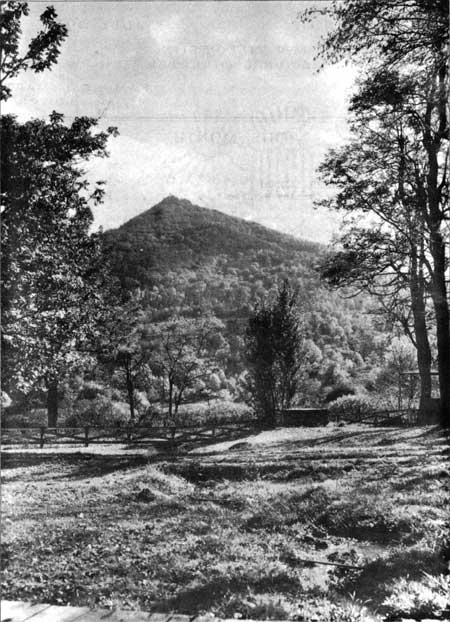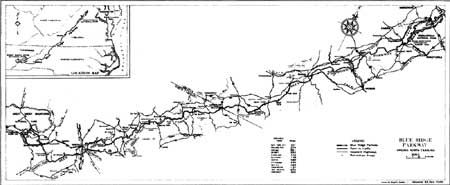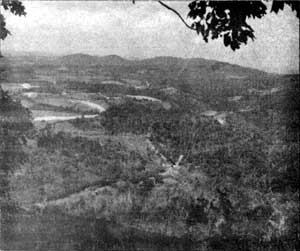|
THE BLUE RIDGE PARKWAY
A New Element in Recreational Planning
By Stanley W. Abbott,
Acting Superintendent,
Blue Ridge National Parkway Project,
Roanoke, Virginia
Recent emphasis on planning regionally for recreation
draws attention to the simple fact that national park development so far
has been limited for the most part to the featured areas which are the
"end" of the motorist's journey from home. For the average family the
way is long to reach the wilderness, especially in the East where
travelers must drive their automobiles among trucks and buses through
miles of commercialized roadway before they "get away" and again as they
return. To the development of recreation the Blue Ridge Parkway is,
therefore, a new note -- something of a first answer to the national
park approach road.

SHARP TOP, ONE OF THE PEAKS OF OTTER
The project is 480 miles long, averages 2,500 feet in
elevation, and will connect Shenandoah and Great Smoky Mountains
National Parks. It is the longest road ever to be planned as a single
unit in the history of American road-building. But the real interest of
the work lies in the dramatic variety of the vast mountain country being
made accessible, the thought that the motorist will travel for nearly
the entire length of two southern states always in the invigorating
coolness of the high mountains, and that through this first tourway will
come the fusion of two of America's most popular national parks into one
huge recreational system. Mindful of the many cliffsides, chasms and
spur ridges that lay ahead to thwart passage of a modern motorway along
the Blue Ridge, more than one expert planner predicted that it would
"fall of its own weight" when this $30,000,000 proposal first was made
five years ago. Now, with more than 100 miles ready for traffic and an
additional 190 in various stages of construction, and with the entire
route plotted on survey maps a steady advance toward its completion
seems reasonably assured. Its character and usefulness should be amply
demonstrated during the next two years as added miles are opened to
connect a continuous route from Roanoke, Virginia, to Asheville, North
Carolina.
The completed portions, such as may be seen by
visitors to the work below Blowing Rock and Roanoke, will differ greatly
from the usual commercial highway principally because of the parkway
idea. Likewise, and because it constitutes a first adaptation of the
broad right-of-way to a rural region, it will differ from such parkways
as Colonial and Mt. Vernon, and those near New York City which have
proved so sound in the suburban plan. It will bear only remote likeness
to the Skyline Drive in the Shenandoah even though it was from the
enthusiastic reception of that road by the public that the Blue Ridge
project had its birthright.

(click on image for an enlargement in a new window)
According to the parkway principle, the states of
Virginia and North Carolina, through their highway departments, are
acquiring for the federal government what is in effect a recreational
area 480 miles long and about 800 feet wide. Through this ribbon-like
park is built the motorway, and instead of sign boards and hot dog and
gasoline shanties, a naturally beautiful roadway becomes possible of
preservation, and where despoiled, possible of landscape improvement. In
effect, an ever-to-be green, and, in places, a primitive cross section
of the eastern highlands has been set aside for motor recreation. The
acquisition of thousands of private tracts more or less in the immediate
path of the steam shovel has required the closest cooperation between
state and federal forces. Studies by the Service call for a taking which
varies in width from 200 to 1,200 feet, and the requirements must be
judged as much for effect upon the residual property as for control of
the roadside picture. Private and public roads, cattle crossings, water
rights, and phone and power lines seriously involve the entire economy
of many larger mountain properties. Relocation of these facilities must
be arranged or the entire holdings purchased outright. Those
considerations and the natural tendency of many mountain people to hold
to the old homes of their forefathers combine to make a more than
usually difficult problem of acquisition, especially if condemnation is
to be avoided.
The Blue Ridge Parkway is laid out expressly as a
route for the leisurely tourist, but there has been little compromise in
meeting the requirements of safety, reasonable speed, and ease of
driving. Viaducts, tunnels, retaining walls and other special devices of
the highway engineer have been employed in subduing the sharp curves and
steep grades that we associate habitually with the mountain road. This
maintenance of a high standard of modern road has meant the "scar" of
machine construction in certain rough and steep-sided mountains.
Occasionally the excavation to create the 30-foot road section mounts as
high as 100,000 yards to the mile. Technicians are confident
nevertheless that landscape and erosion control work, combined with
time, will largely erase this evidence of Diesel power and dynamite. For
the sake of safety, native stone and timber bridges carry the Parkway
over or under important transmountain highways and do away with the
crossing of traffic at grade. Operating policy will limit the use of the
drive to passenger cars only, eliminating the annoyance of the large
truck and bus.
In order to keep construction costs within reasonable
bounds while still maintaining standards of curvature and grade, and
what is more, to avoid excessive scar, it has been necessary to skirt
some of the more rugged regions with the result that the Parkway does
not exclusively follow the skyline, but assumes a changing position in
the mountains. Like the movie cameraman who shoots his subjects from
many angles to heighten the drama of his film, so the shifting position
of the roadway unfolds a more interesting picture to the traveler. The
sweeping view over the low country often holds the center of the stage,
but seems to exit gracefully enough when the Parkway leaves the ridge
for the more gentle slopes and the deeper forests.
The panoramic landscapes seem even bolder for these
contrasts. Of quite different character, but still of interest to the
overall pattern, are the quiet fields and pastures which make unusual
designs in many high land sections. Here among the strange bluffs and
crags and waterfalls an abandoned log cabin, or a water mill long past
its days of grinding grist, chronicles the human history of these very
old American mountains. As much as possible these featured players of
nature and of history on the Blue Ridge have been billed for continuous
performance, and funds made available to the Service have been used to
acquire many of them in their setting and well beyond the normal widths
of right-of-way. In places an area of 6,000 to 10,000 acres embraces a
whole group of mountains. Selected also for logical distribution along
the Parkway, roughly at 20-mile intervals, these parks will provide the
setting for wayside travel facilities. Several areas are being developed
now through the Civilian Conservation Corps and Emergency Relief
Administration work programs. Picnic and camp grounds, motor service
stations, coffee shops and modest lodges will complement those of the
tourist towns scattered through the mountains, rounding out a
self-contained motor vacation land.
Along with the provision of facilities for many forms
of active recreation, large areas in these parks will remain undeveloped
so that the adventurous may withdraw from the Parkway traffic to tramp
or fish in the unbroken forests. Among the notable geographic features
of the Parkway route in Virginia are the George Washington and the
Jefferson National Forests, the Peaks of Otter, and the Pinnacles of
Dan; and in North Carolina, Grandfather Mountain, Linville Gorge, the
Craggy Gardens, and Mount Mitchell, the highest elevation east of the
Rockies. Rounding Asheville the Parkway will dip downward to cross the
French Broad River and then will rise high in the Pisgah National Forest
to approach the Great Smoky Mountains, probably near the Qualla Indian
Reservation of the eastern Cherokees.
Plans for maintenance and protection of the Blue
Ridge Parkway by the Service call for headquarters areas at 60-mile
intervals, or in each third park. Management of traffic on the Parkway
and ranger patrol of an aggregate boundary of 1,000 miles, along which
abut many private holdings, necessarily will develop problems of
administration, certain elements of which will be peculiar to the
Parkway work. Take for example the problem of maintaining Parkway lands.
The charm of many sections in the Blue Ridge lies in the farm fields and
pastures. Should these cultivated areas or the Parkway strip itself be
allowed to return to forest indiscriminately, many of the fine views
would be lost. The Service can hardly expect to grow the corn and wheat,
or to tend the cattle in the pastures, and so has resorted to leasing at
nominal rentals those Parkway lands naturally adapted to cultivation. In
this manner the roadside picture will be maintained without cost to the
United States and better neighbors will be made of nearby farmers.

PARKWAY SEEN FROM ROCKY KNOB,
A Major Recreational Area in Virginia
|
The Blue Ridge Parkway is being built under contracts
supervised by the Public Roads Administration whose engineers have
prepared the plans collaboratively with the Service in accordance with
the interbureau agreement. Amid much talk of a nation-wide system of
parkways and freeways the steady advance toward completion of a pioneer
national tourway seems especially timely. While any national system
doubtless would concern itself primarily with motorways that will serve
as express regional routes, many planners believe that there is a place
for the road of the purely recreational type. Since the Blue Ridge
Parkway will provide days or weeks of well rounded vacation high above
the summer temperatures, remote from the towns and cities and yet within
a single day's travel for 60,000,000 persons, it should test amply the
soundness of the idea. Many officials see emerging from this and from
the Natchez Trace Parkway programs a strong case for a new means of
bringing national parks closer to the people.
|

